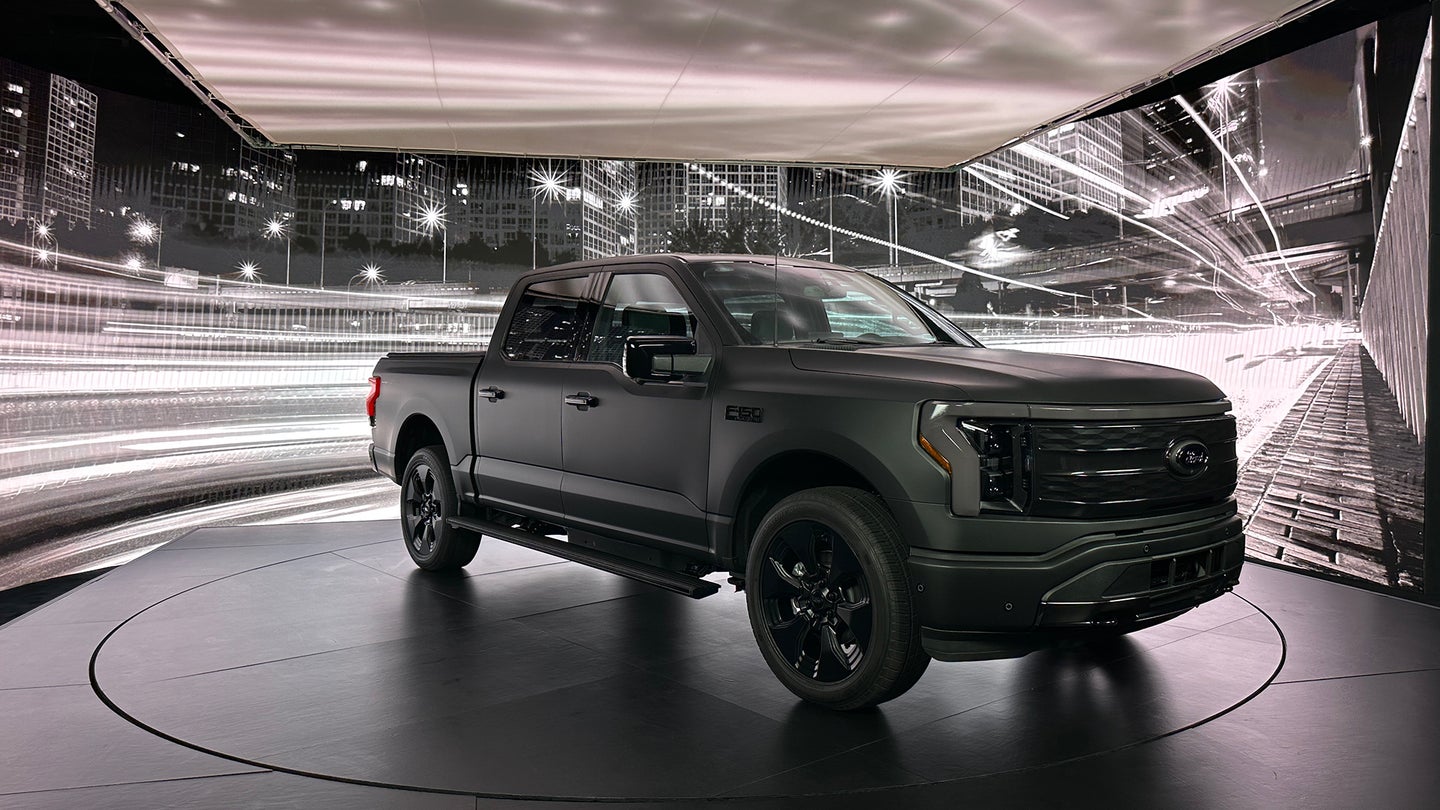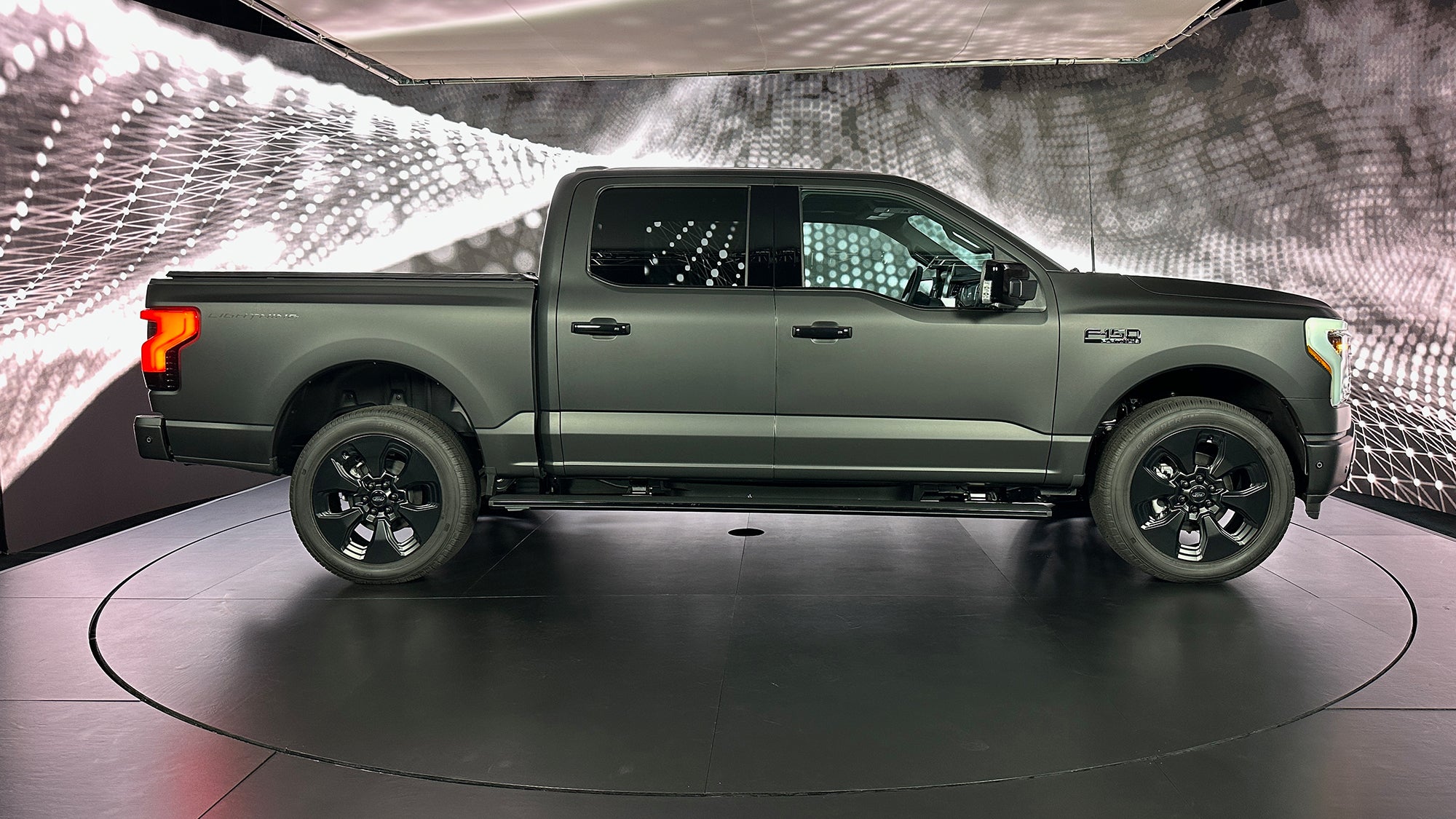
The electric version of Ford’s F-150 pickup, the Lightning, came out in 2022. Now, the automaker is revealing a limited-edition matte-black version of the electric truck. Cloaked in as much black as possible, it’s gorgeous.
To get the vehicle to be this matte black color, Ford has had it outfitted in a 3M vinyl wrap. Parts of the truck, like the side-view mirrors or details on the charge-port door, retain a normal glossy black paint color, which Ford calls “agate” black.
Ford has continued the black theme with other parts of the truck. For example, the 22-inch wheel rims are black, and the lugnuts are—you guessed it—black. The Ford logo in the front, a famously blue oval, is now black. You may also be able to imagine what’s going on in the interior—black leather seats and a black center console.
The vehicle has a Platinum-level trim, the fanciest Lightning version available. The matte-black edition will cost buyers $97,995, and Ford will only make 2,000 of them when it starts delivering them next year. A regular Platinum-level Lightning costs $91,495.

Black is a hot color choice
The arrival of such a chic vehicle certainly makes a bold appearance, but it also can invite a conversation around how a design like this would fare in our increasingly warm summers. After sitting in the sun, an all-black car will probably get toastier than a light-colored car.
In fact, a study published in 2011 in the journal Applied Energy studied just this topic, focusing on a black Honda Civic and a silver Honda Civic parked in the sun on a day in July 2010, in Sacramento, California. The cars soaked in the sun for about an hour, and then had their air conditioning run for about half an hour, and they went through that cycle five times.
The researchers measured the temperature of different parts of the cars as time went on. The roof of the black car reached temperatures of around 176 degrees Fahrenheit or more. The roof of the silver car stayed relatively cooler, never getting hotter than 140 degrees. As for the back seat, it hit over 165 F in the black car and around 156 F in the silver car. The cabin air temp reached higher maximum temps in the black car than the silver car, as did ceiling temperatures. In other words, parts of the black car got hotter than the same parts of the silver car. (The difference between the windshield and dashboard temperatures of each vehicle wasn’t too dramatic, though.)
Ronnen Levinson, the first author on the study and as a staff scientist at the Lawrence Berkeley National Laboratory in California, explains that there are several reasons that cars get hot when they’re in the sun. The first is actually the windows. “If you’re trying to manage the temperature inside the car, the most important thing to do is worry about the glass,” he says. “During the day, you have a lot of sunlight coming in through those windows, and that, more than anything else, is going to heat the car cabin.” This same phenomenon is why homes and buildings sometimes make use of solar-control windows, to keep a house cooler.
The next factor to think about is the obvious one: the paint color. A black car will get hotter than a white or silver one. “When the painted metal is in the sun, if it is an ordinary black, it is going to get much hotter than an ordinary white,” he says. That’s because white can reflect more light than black.
The third variable is the cabin interior: he says that ideally the seats as well as parts like the inside of the doors should be lighter in color, too. The way the interior comes into play is that it can keep radiating heat after the air conditioner has been cranked up. “It actually takes quite a while to lower the cabin temperature,” he says. “And the reason is that all of the solid objects in the cabin, they’ve been cooking in the sun—they keep releasing heat.”
Bottom line: A car with a white or silver paint job and a light-colored cabin is going to stay cooler in the sun than a very dark car, and don’t forget that the windows are actually a big culprit in terms of the vehicle getting toasty, regardless of its color. To deal with the dashboard temperature issue, consider a sunshade for the windshield.

Preconditioning
But don’t let this factor deter you from pursuing the Darth Vader look for your pickup, as there are steps to make the issue better. To mitigate the heat, Vince Mahe, the Lightning’s chief engineer, advises opening the windows and making use of the seat-cooling function, which he says draws less energy than the air conditioner. In an electric car, running air conditioning or heating (as well as other factors) can influence its range. Mahe says that the heater “hurts the range most.”
There’s a step that customers can take at home before they unplug their EV, too, whether they want it to be cooled down in the summer or warmed up in the winter before they depart. “We tell customers in wintertime to do pre-conditioning, so that they can get the battery warmed up, to run at optimal temperature,” he says. That involves having the truck warm up while it’s still plugged into its charger. Here’s more from Ford on preconditioning a Lightning.
The post Ford’s matte-black, $100K Lightning pickup will be hot hot hot (literally) appeared first on Popular Science.
Articles may contain affiliate links which enable us to share in the revenue of any purchases made.
from | Popular Science https://ift.tt/vGZbX0f



0 Comments